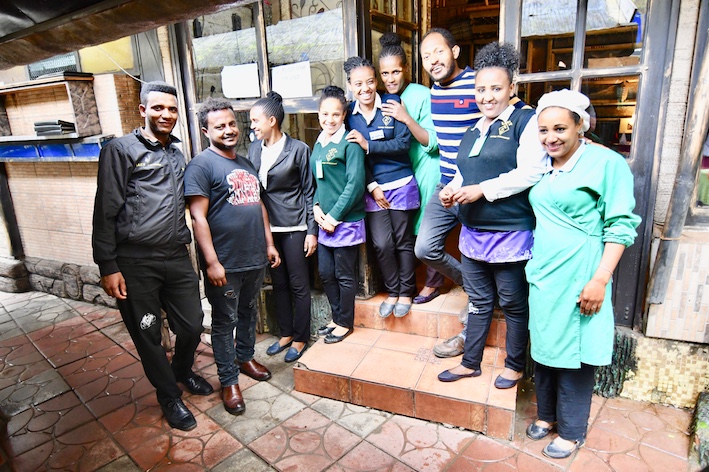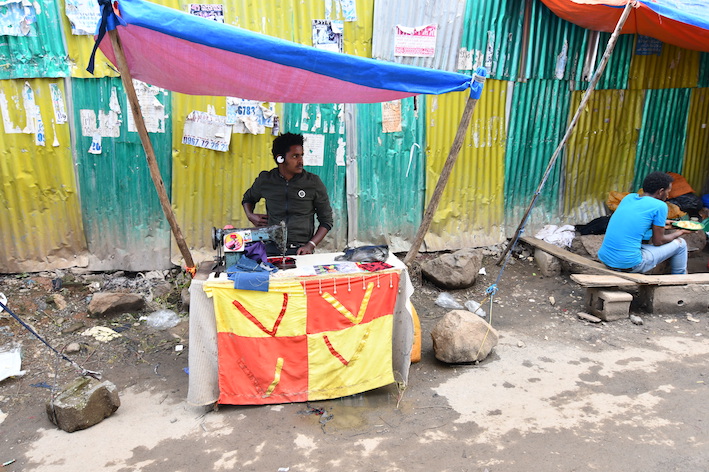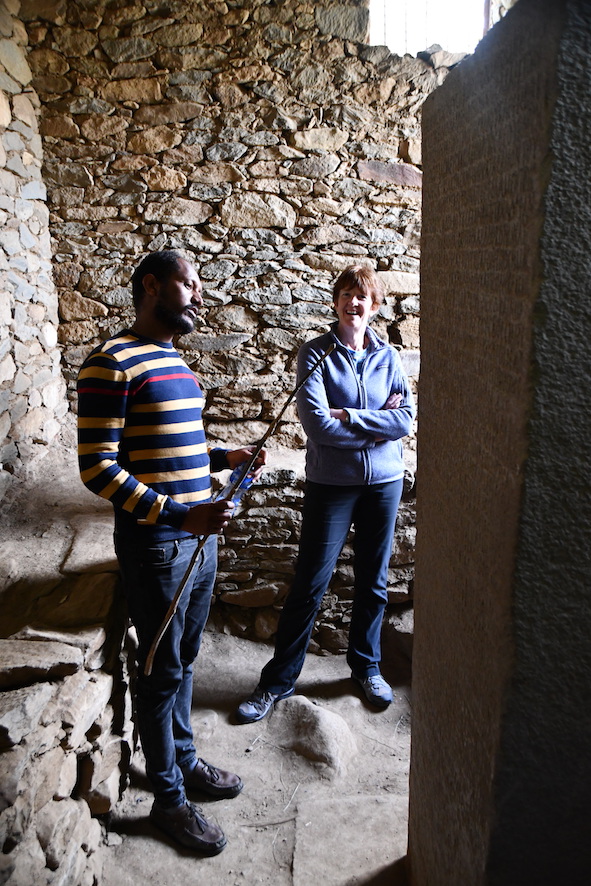Saturday 28 July 2018: Roger
Departing Singapore at 2am on Ethiopian Airlines, with their bright green blankets and bright yellow eyeshades, we had no doubt we were on the right airline.
Landing in Addis Ababa at 6am local time we were bussed to the terminal and really appreciated being first in line as the immigration guy took 10 minutes to process the two of us. Moving out through the unattended customs area we were surprised to see that most of the local hotels had their own little booth in the terminal.
Initially no one was around to meet us; eventually a lady turned up with a sign bearing the name of the travel company and soon we were in a van with our guide, Johannes, and his driver, heading through the quiet streets to the Sheraton Hotel. The hotel and its grounds are impressive; security is taken seriously. A federal policeman sits in the guard alcove AK across his lap. A mirror is used to check the underside of the van. Before entering the lobby we pass through X-ray machines and metal detectors.
Overlooking the hotel is the residence of the prime minister who is currently visiting the US.
After settling into our room, freshening up and a hearty breakfast, Johannes picked us and we headed into town. Addis is the third highest capitol city in the world at 2,500 to 3,000m above sea level. The first stop was a Karl Marx statue, the only reminder of the marxist rule, which lasted from 1974 until the early 90’s when the Ethiopian military was defeated and rebels took control of the country.
Next we headed to the city university, once the palace of Haile Salassie. He ruled from 1930 to 1936 when the Italians invaded. Then again from 1941 to 1974. Apparently in many respects he was a highly rated leader. His earlier name was Ras Tafari and his elaborate coronation ceremony apparently created the Rastafarian movement in Jamaica where he has deity status. After one of his sons tried to overthrow him in the early 60s he gave his palace to the country as a university which it still is today. In front of the palace, part of which is a museum, is a staircase going nowhere. Built by the Italians during their occupation with 14 steps to celebrate 14 years of Facism. With the assistance of the Brits the Italians were thrown out and Haile took over again. Asked what he wanted done with the steps he said “place a Lion of Judah (the symbol of Ethiopia) on them.”
Once known as the hidden Empire, Ethiopia evolved in in relative isolation, protected by fierce fighters and impassable terrain. In the fourth century King Evan was converted to Christianity leading to the creation of the Ethiopian Orthodox Church which is still strong today. The east supports a sizeable Islamic population founded by propheit Mohammed way back.
In the late 1800’s the Italians were defeated when trying to invade. This makes them the only African country not to have been colonised (except for Mussolini’s brief run in the 1930’s). Since the 50’s they have had an on and off scrap with Eritrea which lead in part to the particularly brutal down fall of Haile by the Marxist military regime known as Dergue. They tolerated no dissent and initiated mass killings and forced relocations. When citizens arrived to claim bodies of state murdered dissenters they were asked to pay for the bullets in the victims. During this time Somalia, supported by the US, started a scrap over the Ogaden region.
As we went up the marble staircase a couple of cleaners joined Johannes for a photo. We also had Mekdla, a student, join us for our tour. We checked out various artefacts including drums and wooden discs which are put in women’s lips by a particular tribe. One area we toured by the light from our phones as the power wasn’t working.
Finally we had a tour of the seperate bedrooms used by Haile and his wife; her bathroom in pink and his in blue. Some uniforms and other memorabilia were also on display.
Next stop was the Holy Trinity church, surrounded by a cemetery where armed soldiers guard the tombs of past leaders. There is some contraversy here just now as a few days ago a famous engineer was assassinated on his way to an interview with the media supposedly to expose the corruption of the previous government. People are asking the question as to why soldiers can be provided to protect the dead but are not available to protect the living. There is also a shrine here where many of the heads of the previous government were executed by the Marxists.
Next stop was a restaurant called Lucy’s where we tried a local dish Bozena Shiro consisting of chickpeas, beans, spices and lamb served with copious quantities of Indera bread – gluten free and made from a local grain, teff, this is a main part of the diet here. Washed down with a local beer it tasted pretty good. The staff were super friendly and keen to pose for photos with Johannes and our driver, who are regular visitors.
After lunch we headed to the museum almost next door to check out the real Lucy. Here they have a really interesting board outlining the evolution of man like it was done in 60 seconds, with 0 being 7 million years ago and 60 being 5500 years ago when writing was first used. Various exhibits showed how animals had evolved over time, often to survive a changing environment. These all lead to Lucy who was discovered in the 70’s and is the oldest artefact found of man as an upright walking human.
We drove from there past Yekatit 12 Martyr’s Square with its statue representing the people who had been killed by the Italians in 1936 when they herded some 30,000 people onto the streets and ran them over with tanks and heavy vehicles.
Next we passed the Meyazia 27 Square Monument, a monument to Ethiopia overcoming Italian racism.
From there we headed to the centre of town where the metro rail begins. A number of buildings under construction or repair have eucalyptus branches and sticks used as scaffolding, apparently a common practice here.
The streets are dirty and dusty with lots of stalls set up along the road side. A bright blue Mosque is under construction amongst the rubbish that lies around the landscape.
Next we drove through the Merkato, one of the largest market places in Africa. It was like nothing I have ever seen before. It has evolved into sections; there is one area where they are remaking umbrellas from salvaged parts, in another there are people sewing and doing alterations, another seems to be recycled pots and pans, another electrical wire. And on it goes. Scrap arrives on top of cars and vans to be recycled. Looking down alley into the background there are thousands of shacks all with a satellite dish. Women process food, men carry huge loads on their backs or heads. Clusters of blue and white taxis, some Toyotas, many Lada’s gather in groups, many hardly looking road worthy. Amongst this absolute chaos people are smiley and friendly. Even the photos cannot truly describe what we saw here. Stuff arrives here as rubbish to be resurrected and sold in the thousand of stalls which also provide food for the locals.
Sunday 29 July: Sylvia
This morning we were up bright and early with a 6:20am pick up at the hotel to transfer to the airport for our flight to Axum. At one point we came across long lines of cars stopped – apparently a random search underway due to the funeral in town this afternoon so we did a quick U-turn and took a different road to the airport.
As with many developing countries chaos ensued at the airport. Queueing is definitely not practiced here – people pile over each other to get to the front of the line. It is good to be in relaxed holiday mode!
Once on board the Q400 Bombadier propeller plane it was an easy 1 hr-30 flight to Axum. Axum is situated in a rural plateau with lots of agriculture. On our way into town we passed several trucks filled with young men, horns honking as they headed to a demonstration. We also passed lots of buildings in various stages of development. Apparently the government takes the land back if building is not started so people complete as much as they can and then wait for more money before doing more.
We checked into the Sabean Hotel – simple and clean, then headed back out with Johannes to tour the area. Axum is the oldest known Christian community in Ethiopia. It all dates back to Solomon and the Queen of Sheba. He converted her to Judaism so this was originally a Jewish area. Legend has it that the original arc of the covenant was transported to Ethiopia and remains in one of the large churches here in Axum.
We visited the ruins of a Jewish temple dating back over 2000 years. An Ethiopian eunuch was converted to Christianity in the early AD period and the Jewish temple was converted to a church. But not everyone converted and in the 9th century AD a female Jew lead a rebellion against the Christians in Axum and destroyed the temple. Churches were rebuilt in later years including one that women are not allowed to visit so I sat outside – much to Roger’s amusement. I was quite content to watch the many beautiful and often brightly coloured birds.
People here are incredibly friendly and seem to like to try out their English on us ferengi. And the kids are not shy about asking for money or a football either… and always with big smiles on their faces.
Next we visited the cathedral of St Mary Zion. It is in a small chapel outside this cathedral, also built by Haile Salassie, that the arc of the covenant is said to reside. Apparently only one chosen deacon ever sees the arc. He lives inside with it and is provided for by another deacon. They are building a new chapel next to the current one as it is starting to leak. Roger suggested that he might try and fly a drone overhead when they are moving the arc to the new building so someone can actually get a look at it.
The cathedral itself is a large cavernous building with many bright paintings inside depicting biblical stories of significance to the Ethiopians. It is clear the the Ethiopian Orthodox Church plays a critical role in the lives of Ethiopians with around 50% ascribing to this religion.
Next we visited a small, dilapidated museum show-casing numerous religious relics and the crowns of many of Ethiopia’s kings. Everything was stored inside glass cabinets but still looked dusty and dirty. Despite the security (no electronics or cameras – we had to lock them up outside and were scanned before entering), it certainly wouldn’t pass as a museum back home.
We headed up the cobbled road (they are not allowed to use tar seal here as they do not want to damage any of the other old buildings that lie buried here) to the ruins of a castle of a couple of kings from the 6th century AD. We also stopped at a small shack housing a large slab of granite engraved in three languages telling the story of King Ezana’s (4th century) victories over his enemies.
After lunch and a rest at the hotel we headed out agin this afternoon, first to look at a field with about 70 monolithic stelae in them, three of them exceedingly large and engraved with different patterns. At 34m apparently one is the largest obelisk in the world. Archeologists are divided as to their purpose but it seems most likely they were grave markers given they have unearthed several graves and interconnected rooms under the field. There is a field outside the town with a number of smaller stelae in. Roger remarked that they were waiting for some fertiliser to help them grow.
We also visited the ruins of the palace of the Queen of Sheba and heard a more detailed version of the legend of her union with Solomon that led to nearly two thousand years of Solomic dynasty, ending in 1974 when Haile Salassie was dethroned. Legend or truth, there is no doubt that the locals believe the story and have built their religion on its basis.
Before heading back to the hotel for the evening we drove around the town and watched the locals going about their usual Sunday activities. There is a large university on the outskirts of town and many small businesses have sprung up along the roadside catering to the needs of students. We stopped at one stall and participated in a coffee ceremony with some of the locals.


















































































Hello. How was Ethiopia.
Superb reading!
We are still here, now at Bahir Dar. We are having a great time and will publish another story soon. We head south tomorrow.
Hi mister how was your visiting
How was the visited? How did u get Ethiopia?
The market looked incredible!
Amazing trip you guys – (I was invited to give a talk at a festival of Satire in Nairobi 2 years ago, and couldn’t go because I couldn’t get any form of travel insurance for that region. (work-related) regional and personal security was a big issue then. )
Fascinating and as you say intriguing.
Yes, use that drone to photograph tha Ark.
Loved hearing about King Soloman and Queen of Sheba!
Hi Guys: We’ll have to tell our Lucy and your ‘Lucy’ experience. We remember seeing a similar exhibit in the Natural History Smithsonian museum in DC. Amazing photos and story! Nice one.
Go well!
C&N x
Looks like a very interesting trip
Thanks for sharing
Dayne Campbell
Wow! Thank you, you two. What amazing places. You look very relaxed Sylvie. Thank you for the details and all the great photos – we really appreciate them. Travel safely, and we look forward to the next instalment. Xxx